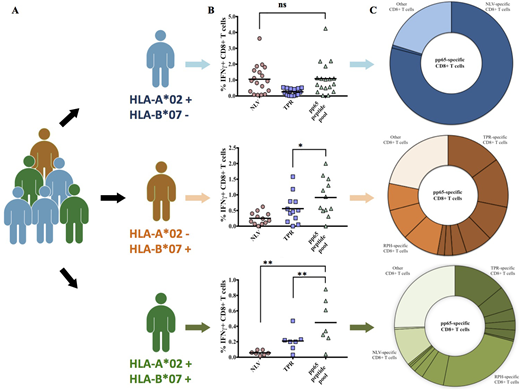Background: Cytomegalovirus (HCMV) infection is one of the major complications and causes of mortality in patients receiving immunosuppressive therapy following hematopoietic stem cell transplantation (HSCT). Antiviral drugs have limited efficacy and high toxicity while using CMV-specific T cells from healthy individuals as a cellular vaccine had proven to be safe and efficient.
Conventional protocols rely on expanding virus-specific cells ex vivo while more recently it was proposed to transfuse relatively small numbers of minimally manipulated cells and allow them to expand in vivo.
To isolate virus-specific cell one could use either the stimulation with overlapping pools of peptides covering the whole immunogenic viral protein followed by isolation of INFγ-producing cells, or direct isolations of cells bound to MHC-multimer loaded with known immunodominant peptides.
Both methods have their advantages. The former approach isolates all activated clones irrespective of their MHC-restriction and supplements CD8+ cells with CD4+ fraction, while the latter method is faster and simpler, besides it captures cells irrespective of their ability to produce IFNγ.
The efficiency of the two methods was not directly compared and it is currently unknown to what extent T-cell populations isolated by these two approaches are different in terms of absolute quantity and clonal composition.
Aims: to compare the quantity and T-cell receptor repertoire composition of T cells specific to pp65 CMV and to pp65-derived immunodominant epitopes NLV restricted by HLA-A*02, TPR and RPH restricted both by HLA-B*07.
Methods: PBMC of healthy donors with different combination of HLA-A*02 and HLA-B*07 alleles were stimulated with peptides of immunodominant epitopes or overlapping peptide pool covering the entire pp65 CMV (Miltenyi Biotec, Cat.-130-093-435). Antigen-specific T cells were detected by the intracellular staining for IFNγ and flow cytometry.
We obtained fractions of virus-specific T cells from PBMC either by MHC-tetramer staining or IFNγ secretion assay followed by fluorescent activated cell sorting. Then we prepared cDNA libraries of TCR α- and β-chains and sequenced them using NGS. Characterization of TCR repertories was performed by proprietary bioinformatic pipeline.
Results:
T-cell response to pp65 CMV is strongly focused on immunodominant pp65-derived epitopes. In donors having HLA-A*02 and/or HLA-B*07 absolute majority of pp65-reactive cells are specific to one of the three immunodominant epitopes - NLV, TPR and RPH.
Immunodominant antigens are structured in a fixed hierarchy. TPR and RPH are superior to NLV. When HLA-B*07 is present response to the NLV epitope is drastically reduced, most of the pp65-specific cells recognize either TPR or RPH epitopes.
TCR repertoire of the NLV-specific T cells is highly skewed and consists of few large dominant clones. TPR and RPH-specific T cells are more clonally diverse.
Substantial share of the cells belonging to the large clones specific to the immunodominant antigens do not secrete IFNγ upon antigenic stimulation. Nevertheless, they may be therapeutically valuable, as they might secrete other cytokines.
Conclusion: In summary, CMV-specific response in donors positive for HLA-A*02 and/or HLA-B*07 is focused to the combination of three immunodominant epitopes - NLV, TPR and RPH. Substantial share of the cells are not IFNγ-producers. For the patients having these alleles it might be beneficial to use MHC-multimers for isolation of the therapeutic lymphocytes.
Figure 1:
A - Healthy donors with different combination of HLA-A*02 and HLA-B*07
B - Intracellular staining for IFNγ of CD8+ T cells after stimulation with pp65-derived peptides
C - NGS to identify clonally diverse of pp65-sprcific T cells on combination of HLA-A*02 and HLA-B*07
No relevant conflicts of interest to declare.
Author notes
Asterisk with author names denotes non-ASH members.


